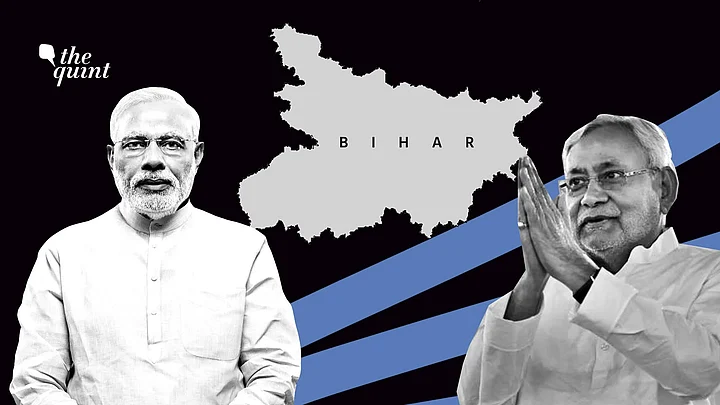Will BJP let Nitish Kumar become CM again if the NDA comes to power? Or will the party insist on having its own CM?
These are questions that BJP leaders have been facing from the media and from the party's own supporters.
The answer to these questions isn't simple. The reason for this is that there is a divergence between what the party leadership wants and what its supporters and workers want.
What the BJP Leadership Wants
BJP insiders told The Quint that the leadership question isn't important for the party.
The party's slogan "Pachees se Tees, Narendra aur Nitish" (2025 to 2030, Narendra Modi and Nitish Kumar) makes it clear that the BJP has no plans of doing away with Nitish Kumar as CM.
What the BJP seeks this time is dominance over governance in Bihar.
The party has already achieved one milestone by contesting the same number of seats as the JD-U for the first time in an Assembly election.
It wants to come out of Nitish Kumar's shadow, even if it means continuing with him as a figurehead.
Nitish Kumar has directly or indirectly ruled Bihar for the past 20 years, and 15 of these have been in alliance with the BJP.
The BJP has steadily been growing in popularity in Bihar, especially under Prime Minister Narendra Modi's leadership. By most accounts, the BJP's base on the ground is now more than that of the JD-U. In 2020, BJP got 19.5 percent votes against JD-U's 15.4 even though it contested five seats lesser than its ally.
Even in the government, it has gone from 14 ministers from 2017 to 2020 to 16 (2020-2022) and over 20 in the outgoing government.
However, when it comes to governance, Nitish Kumar has cleverly managed to keep the BJP away from two ministries that are central to its ideological agenda: Home and Education.
As the police has been in Nitish Kumar's control, Bihar hasn't seen the kind of anti-Muslim actions that have become characteristic of BJP ruled states. For instance, Bihar didn't witness the kind of crackdown against anti-Citizenship Amendment Act protesters as we saw in Uttar Pradesh or Karnataka (then ruled by BJP). Then unlike Madhya Pradesh, Uttar Pradesh and Uttarakhand, Bihar doesn't have an anti-conversion law.
Though pro-Hindutva sections have made inroads in education and curriculum development, it isn't of the scale one sees in BJP-ruled states. In the absence of ideology-driven policies and anti-Muslim measures, Bihar appears very different from BJP-ruled states, even though the party controls a majority of the ministries.
It is this state of affairs that the party leadership wants to change.
However, this is easier said than done. Nitish Kumar presently has more leverage than he did five years ago. The Modi government at the Centre is critically dependent on the JD-U and the Telugu Desam Party for support.
So while Nitish Kumar may still have the option of striking a deal with the Mahagathbandhan if the BJP pressurises him more than he wants, the BJP doesn't have an option besides Nitish in Bihar.
What BJP Supporters Want
For BJP's rank and file and much of the party's support base, the party's moment has come in Bihar. BJP has not only secured more votes than JD-U in 2020, it has also dominated three Lok Sabha elections in the state in a row under PM Modi's leadership.
In 2014, the BJP and its allies won 31 seats, the JD-U won just 2 contesting alone. In 2019 the NDA won 39 out of 40 seats with the BJP winning 17 of those and JD-U 16. And in 2024, the alliance won 30 seats with BJP and JD-U winning 12 each.
In contrast, the 2020 Assembly election fought under Nitish Kumar, was much closer.
For BJP workers and core supporters, these results are a clear message that Bihar has decisively been in favour of PM Modi. So the question many of them ask is: why shouldn't Bihar have a BJP CM?
There is a caste angle to this as well.
Bihar hasn't had a Savarna CM since Congress' Jagannath Misra in 1990, such has been the entrenchment of social justice-based parties like the RJD and JD-U.
BJP's Savarna supporters see the example of neighbouring Uttar Pradesh where Yogi Adityanath's rule brought back a return to Upper Caste domination in some ways.
Though Nitish Kumar has always presented himself as a social justice leader who isn't hostile to Savarnas, the desire among dominant castes to have their own CM has only become stronger.
Partly, this is also due to the job crisis in Bihar, including among Upper Caste youth.
There are fears in the BJP that a small section of Upper Caste youth may gravitate towards Prashant Kishor's Jan Suraj Party as he is the only Upper Caste CM candidate among all the parties in the fray.
To prevent any leakage in their Upper Caste vote bank, the BJP has increased the proportion of Upper Castes in the granting of tickets. According to Hindustan Times' analysis, 49 out of BJP's 100 candidates are from Upper Castes. This has increased from 44 percent in 2020, according to The Print.
What Lies Ahead?
Given the leverage Nitish Kumar presently has, it is unlikely that the BJP will be able to impose an arrangement he doesn't like if the NDA comes to power. So Nitish Kumar may make way for a BJP CM only if he is offered something in return, such as a president or vice-president's position at the national level.
The best case scenario for the BJP would be if it can arrive at a transition plan with Nitish Kumar that eventually leads to his making way for the BJP CM somewhere down the line in return for a respectable exit and prominent positions to his chosen successors.
